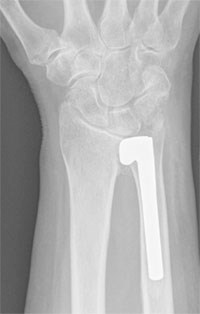Find experienced and well trained Hand Surgeons across the UK
Currently there are a number of different implants in use. The Herbert distal ulna replacement has been available for a number of years and is involves the replacement of the distal ulna. A newer and more versatile implant is the Ascension® First Choice® DRUJ System. This is either a partial or modular distal ulna.

The principle indications for replacement are:
- Joint incongruity post distal radius fracture
- OA
- Painful instability following previous surgery eg. Darrach’s, Bower’s and Sauve-Kapandji procedures
Post op regime:
- Sugar tong POP in theatre with DRUJ at 20 degrees supination
- One post op dose of antibiotics
Operative details will dictate the exact nature of post-operative management, but implant stability, extent of soft tissue reconstruction, intra-operative complications, pre-operative range of movement and individual patient characteristics dictate the length of the initial period of immobilisation in a Sugar Tong Splint / above elbow POP to control forearm rotation.
Post-operative Management Guidelines

Where stiffness is likely:
- Sugar Tong POP is applied in theatre and converted to a sugar tong splint as comfort and oedema dictate
- Mobilisation of the DRUJ commences at 2 weeks.
- Active and passive exercises
- Support the joint in a splint, for comfort, between exercises and to protect against forced rotation.
Where instability is likely:
- A Sugar Tong POP to control forearm rotation is applied in theatre and converted to a Sugar Tong splint as comfort and oedema dictate.
- A clinical and radiological assessment is carried out at 5-6- weeks.
- If x-ray satisfactory and implant stable rotation block splinting can be discarded and unrestricted mobilisation commenced. If necessary, for comfort, or concerns related to heavy activity, a removable below elbow splint should be provided.
- If instability is still likely to occur controlled mobilisation, within the limits of stability, is commenced and a sugar tong (or substantial below elbow splint) retained for between exercise and at night. This is discarded when stability is achieved.

- When movement potential has been maximised strengthening exercises are encouraged.
- Return to work at 12 weeks.
- Heavy manual occupations and stucatto movements should be discouraged to protect the implant from loosening and/or dislocation
Links:
Evidence:
Herbert,T.J., Herbert Ulnar Head Prosthesis, Martin Manufacturers Literature
Herbert,T.J., Van Schoonhoven,J., Ulnar Head Prosthesis: a new solution for the problems at the distal radioulnar joint. In: Hand Arthroplasties. Eds.,Simmen, Allieu, Ll uch, Stanley. Pub.Martin Dunitz. 2000
De Smet,L., Peeters,T. Salvage of Failed Sauve-Kapandji Procedure With an Ulnar Head Prosthesis: Report of Three Cases. Journal of Hand Surgery, British and European Volume 28B. p271-272
Stanley, J.K., Causes of stiffness of the distal radioulnar joint. In: Joint Stiffness of the Upper Limb, Eds.Copeland,Gschwend,Landi,Saffar. Pub.Martin Dunitz.1997.
Saffar,P., Treatment of stiffness of the distal radioulnar joint. In: Joint Stiffness of the Upper Limb, Eds.Copeland,Gschwend,Landi,Saffar. Pub.Martin Dunitz.1997.
Gwilliam,L., Rehabilitation of the distal radioulnar joint. In: Joint Stiffness of the Upper Limb, Eds.Copeland,Gschwend,Landi,Saffar. Pub.Martin Dunitz.1997.


